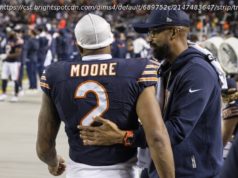Some people make good money playing video-game football for a living. Most are just trying to hang out without getting shot.
On Sunday afternoon, a man shot and killed three people, including himself, and injured at least 11 others at a Madden NFL video-game tournament in Jacksonville, Florida. The Jacksonville police impounded the shooter’s car, suggesting that he drove down from his home in Baltimore (which the FBI has since raided). It’s not yet known whether he planned to commit the violence at the tournament, or if the shooting was a crime of passion.
Details are not yet entirely clear, but authorities announced that the suspect is a 24-year-old white male who had been competing in (and had been eliminated from) the tournament. Police have not released a possible motive, but according to witnesses, the man was seen quarreling with other competitors before the shooting began. The dead are two players on the Madden circuit, 22-year-old Eli Clayton (who goes by the nicknames “true” and “trueboy”) and Taylor Robertson (aka “spotmeplzzz” or just “spotme”). In a livestream of the event, Clayton can be seen smiling as he competes, just before the shots rang out, unaware of the red glow of a laser-sight on his chest.
Mass shootings are so frequent that the fact of senseless murder often becomes subordinated to the details of its context: a church, or a school, or a movie theater, or a shopping mall. That instinct speaks to how pervasive and intractable gun violence feels in America, for one part. But it also shows how desperate citizens of all kinds are to explain their causes. To some, guns are the direct cause, a fact deployed in calls for and against gun control in their aftermath. But cultural factors dilute those ideas, making some massacres seem more tragic than others. There’s a risk that a football-video-game tournament will seem less urgent than a university or a place of worship. But this tragedy is no different than any. Once again, more people trying to live and play in America were shot dead in that innocent act for no reason, or for bad reasons.
For people who play, make, or study video games, that medium seems to get a particularly bad rap when men commit violence. Eric Harris and Dylan Klebold famously “practiced” their 1999 massacre at Columbine using the popular first-person shooter game Doom. After Adam Lanza shot 20 six and seven-year-olds at Sandy Hook Elementary School in 2012, investigators who raided his mother’s home reported finding “thousands of dollars’ worth of violent video games.” These worries about video-game violence and its impact on real-world behavior stretch back decades. In 1976, the black-and-white arcade game Death Race caused a controversy because players could drive blocky “cars” over stick-figure “people.”
But in Jacksonville, a different kind of game was at the center of the murders, played in a different way than people might be familiar with. Madden NFL is a long-running franchise of American football titles, made by Electronic Arts and licensed by the NFL to include real teams. The game has been produced in some form for three decades, and EA Sports releases a new edition each year with updated rosters and new features. For years, that was the end of it—people bought Madden NFL and played it alone or with friends, first in the living room, and then online.
But over the years, the game’s uses have evolved. Since 2004, EA has run an annual simulation of the Super Bowl in the game, with surprisingly accurate results. An annual Madden Bowl competition began in 1995. That idea, once a curiosity, has since evolved into an entire competitive league for video-game football. Players have followings and sponsors, there is prize money to be won, and the events draw crowds of spectators, in person and online.
Madden is not alone in this trend. Dozens of games enjoy spectated, competition play these days, from first-person shooters like CounterStrike: Global Offensive to last-man-standing games like Fortnite to card games like HearthStone to strategy games to fantastic, computerized takes on sport like Rocket League, where car-racing meets soccer. This practice is frequently known as esports, a name that communicates its aspirations: to meet, if not exceed, the cultural role of traditional sports in the cultural imagination.
This is a fraught effort, to be sure. For one, it dredges up old culture wars. Sports traditionalists sometimes sneer at the idea that pressing buttons on a controller should count as “sport”—even the couch potatoes who couldn’t compete even if they wanted to. But on the flipside, players and creators of games sometimes sneer at traditional “sportsball,” deeming it a thuggish pursuit that occupies too much time, money, and attention. It’s too simplistic to call esports a continuation of the war between jocks and nerds, but that old rivalry does have relevance here.
Meanwhile, competitive activities of all kinds flourish. Poker has transformed from a seedy casino game into a beloved spectacle of wit and fortune. The national spelling bee gets televised on ESPN. The idea of competitive chess leagues wouldn’t strike anyone as odd, and many people partake of sports for kids for social reasons more than athletic ones anyway. Almost anything whatsoever that is interesting enough to do once has the potential to be transformed into competition. There are Rubik’s Cube tournaments. There’s competitive Rock-Paper-Scissors. The World Sport Stacking Association regulates competitive plastic-cup stacking (I’m serious, and it is incredible). When people start competing in an activity, it’s a good sign that a large group of them are taking it seriously.
Madden NFL represents an interesting middle-ground between the cultural fringe and mainstream. On the one hand, it’s still a video game, and for some that whole category is indistinct, a prurient sludge of indiscriminate delinquency. Gamers are used to this, and before the police tape came down in Jacksonville, some were decrying hypothetical, future redress of the incident on the grounds that games are violent (“Last I checked there’s no guns in football”).
Even without the violence, game culture has become associated, both fairly and unfairly, with social isolation and disconnection. The 2014 GamerGate smear campaign prefigured (and rehearsed) other online conspiracies, prefiguring and practicing the rise of alt-right conspiracy culture writ large. It also underscored a community of young men with deep feelings of marginalization, despite their position of structural sociocultural advantage, who have not yet been offered persuasive solutions to their despair, whether it is justified or not. And even if football has no guns, and even if there’s no convincing evidence that violent games cause violent behavior, video-game culture has been so frequently associated with grotesque images of violence, its participants shouldn’t be so surprised at their hobby’s reputation, whether it is earned or not. The savvy critic might observe that it was Doom ’s user-editable levels that appealed to Harris and Klebold, not necessarily its violence. But that clarification doesn’t sound much better to the average parent or school principal.
But on the other hand, Madden is football. Old, rough, officially-licensed NFL football. With all the teams and players, and carrying all the cultural weight—and baggage—of America’s most popular sport. It would be wrong to say that football is not a violent sport. Indeed, the risk of concussion and, over time, Chronic traumatic encephalopathy (CTE), has become as widespread a topic of conversation as the NFL draft.






